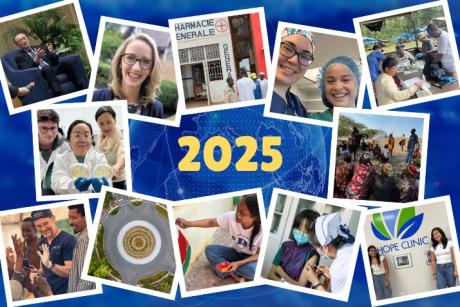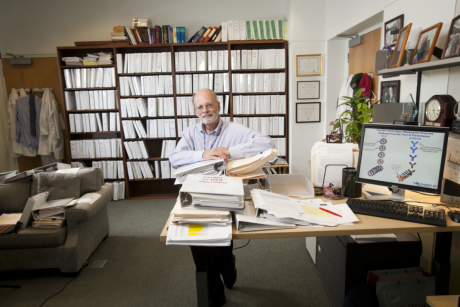Watch the full Think Global event on lessons from the U.S. COVID response.
Published April 5, 2024 under Around DGHI
In the four years since the start of the COVID-19 pandemic, much has been written about the surprisingly high death rates experienced in the U.S., which accounted for 16 percent of all COVID deaths worldwide despite having just 4 percent of the global population. But mixed in with those failures were some notable successes, such as how emergency stimulus payments lifted many families out of poverty and eviction bans allowed those who lost their jobs to stay in their homes.
Those complicated outcomes are one reason why discussion about the U.S. response to the pandemic is so important, noted Ana Diez Roux, M.D., a distinguished university professor of epidemiology at Drexel University.
“COVID opened a door in some ways, and we have to put a foot in it and not let it close,” Diez Roux said during a panel discussion about the U.S. pandemic response at the Duke Global Health Institute on April 2. “If we can keep this momentum, we can change things… which are under our power to change.”
Diez Roux was joined on the panel by the lead authors of a series of articles published by the BMJ this spring. Co-edited by Diez Roux and DGHI global health professor Gavin Yamey, M.D., the papers analyzed the socioeconomic and systemic forces that influenced COVID’s impact on the country, and particularly the disproportionate outcomes for racial minority groups and vulnerable population.
Yamey, director of the Center for Policy Impact in Global Health at DGHI, said the discussion was not about assigning blame.
“We really have to learn lessons from failure,” said Yamey, the event’s moderator. “It’s crucial if we want to prevent another million deaths in the next pandemic – learning from the past to create a better future”
Race, racism and COVID-19
COVID-19 hospitalizations and deaths were highest in Black, Latino and indigenous communities. One factor in those disparities was a tendency to blame individuals’ susceptibility or behaviors, rather than the systems that fell short in protecting them, said Keisha Bentley-Edwards, Ph.D., a DGHI affiliate and the associate director for research at Duke’s Samuel DuBois Cook Center on Social Equity.
“There’s this myth that we are all in the same boat and in this together but as different outcomes become apparent, it’s clear we aren’t,” she said. “It’s not just looking at different outcomes based on race, but based on racism.”
Despite the shortcomings, Bentley-Edwards pointed out positive approaches enacted during the pandemic, such as strong community advocacy for vaccine rollouts and eviction bans. She said the pandemic showed the power of such measures to benefit the health and economic stability of marginalized communities, and they should be continued even in times when there isn’t a public health crisis.
Bentley-Edwards said the success of stimulus payments offer a strong argument for actions such as reparations to racial minorities. She challenged the argument that “you can’t just throw money at the problem,” noting that the pandemic showed when you give people direct financial support, “they aren’t poor anymore,” she said.
The hollowing of public health
When Mary Bassett, M.D., served as the New York state Health Commissioner during the pandemic, she found the department lacked the staff and resources to actively respond to such a major health crisis. She said public health agencies have suffered from a “hollowing of the state,” a long-term pattern of diminished funding and has eroded their capacity.
“Government public health had been kneecapped long before COVID,” said Bassett, director of the François-Xavier Bagnoud Center for Health and Human Rights at Harvard University. “It’s a symptom of a more fundamental problem – political divestment from state capacity.”
Measures such as the CARES Act and the American Rescue Plan provided trillions in funding, but were short-lived, Bassett said. She noted that many underfunded governments outsourced work to private consulting firms that had no public accountability or mission.
“Structural issues like racism [shouldn’t] be managed by managing consultants,” Bassett said, noting the need for an ideological shift that embraces a stronger role and resources for government to take actions that are in the public interest.
Uneven risks, inadequate protections
Throughout the pandemic, frontline and essential workers were put in positions that risked their health. Often, the policies that were supposed to protect them did more to protect business interests, said David Michaels, Ph.D., an epidemiologist and professor at the George Washington University School of Public Health.
“It became clear that wage inequality, housing segregation and a lack of provider benefits all meant that vulnerable workers were at an elevated risk for disease and death,” he said. “Too many workers paid for that with their lives.”
Michaels, who worked in the U.S. Department of Labor under two presidents, said stronger support for workers should include adequate paid sick leave and protections from emissions and unsafe working conditions.
“As a nation, we need to focus on clean air in work places, but also in schools, nursing homes and indoor locations where we spend many hours,” he said. “We need better coordination between worker safety and public health systems.”
COVID-19 in U.S. prisons
Some of the largest clusters of COVID cases early in the pandemic occurred in jails and prisons. Lauren Brinkley-Rubenstein, Ph.D., an associate professor of population health sciences at the Duke School of Medicine, said that’s an outcome not just of overcrowded conditions, but also of the underlying health of incarcerated people. She noted that people in U.S. prisons typically have at least two chronic health conditions and are generally in poorer health than the average American.
“Most prisons were at 104 percent capacity at the start of the pandemic, and they had a lack of access to routine healthcare and air conditioning,” said Brinkley-Rubenstein, who co-founded the COVID Prison Project that analyzes testing, cases and deaths in the prison systems across the nation.
Brinkley-Rubenstein called for decarceration as a way to limit the spread of illness in addition to more transparency and data mandating related to inmate health.
“COVID showed there needs to be more public health actors at the table deciding what happens in jails and prisons,” she said. “And [we need to[ make sure there is a clear understanding that the health of people incarcerated affects community health [when they] become community members.”
Legal infrastructure for pandemic response
Michelle Mello, Ph.D., an empirical health law scholar at the Stanford University School of Medicine and the Department of Health Policy, noted that the U.S. Constitution does not require officials to take action to protect public health. That legal loophole created an opening for attacks on public health measures in the courts.
“The federal response was delayed and anemic, when the federal government did try to mount a vigorous response, it found itself hemmed in by the courts,” she said. “It set the conditions for public backlash.”
Mello said governments at all levels should be working to clarify their ability to respond to public health emergencies. But she noted that in many states, laws have already been passed that limit government’s ability to respond even further.
“We’ve got endemic problems with the public health legal infrastructure, it has set us up for pandemic responses that are inequitable because these reforms are a matter of state law,” she said. “We need to empower public health officials to do what they weren’t able to do during COVID.”


